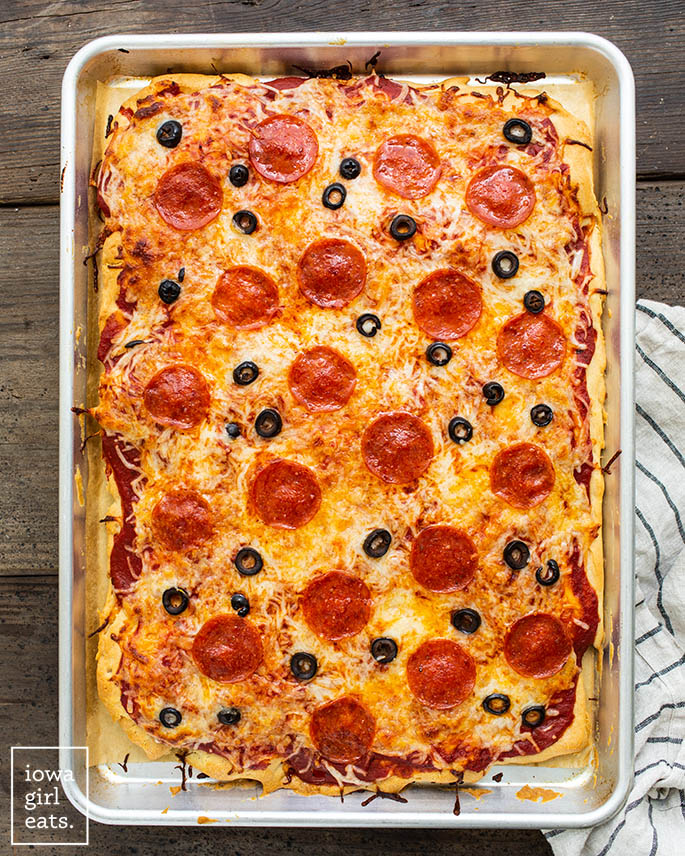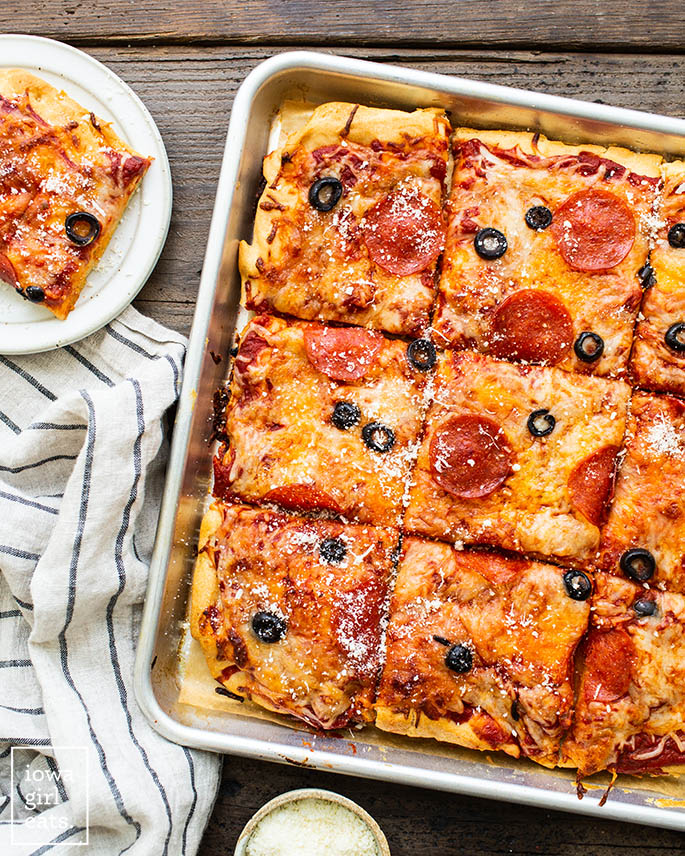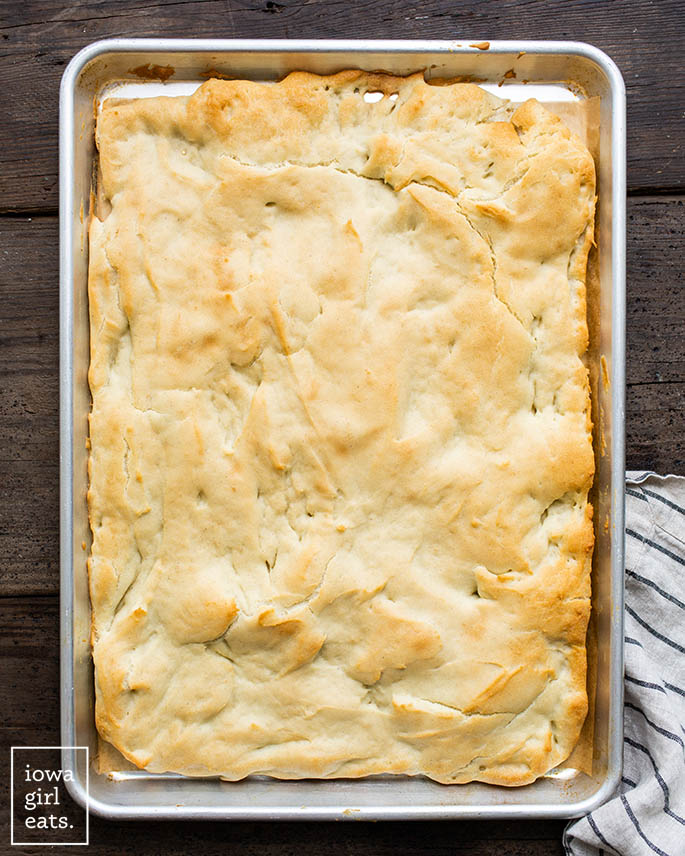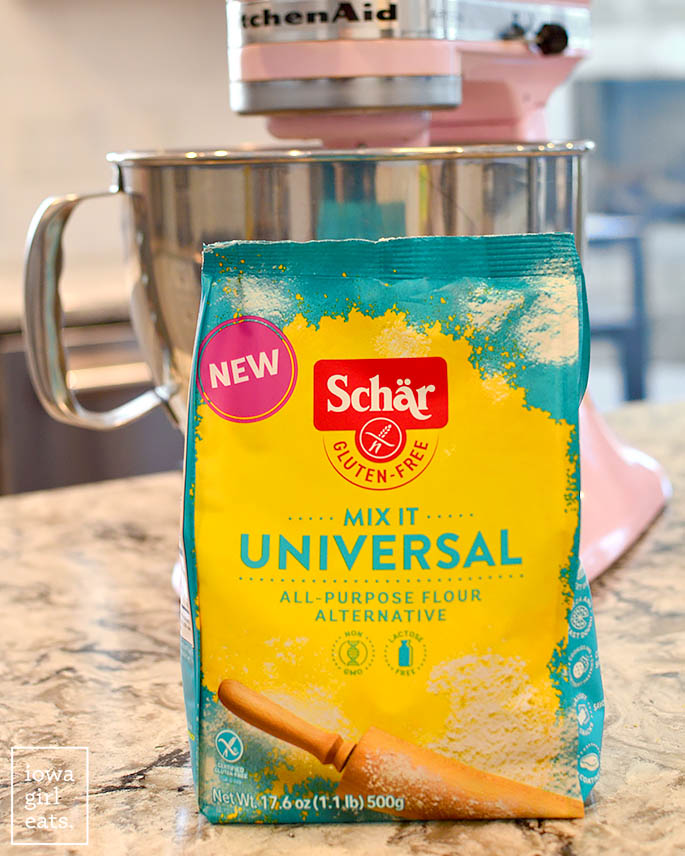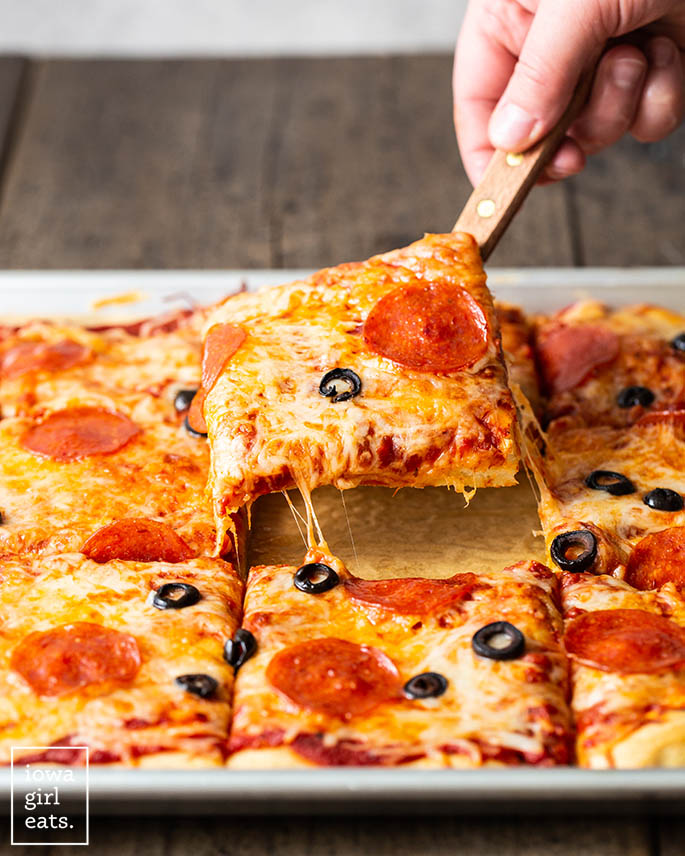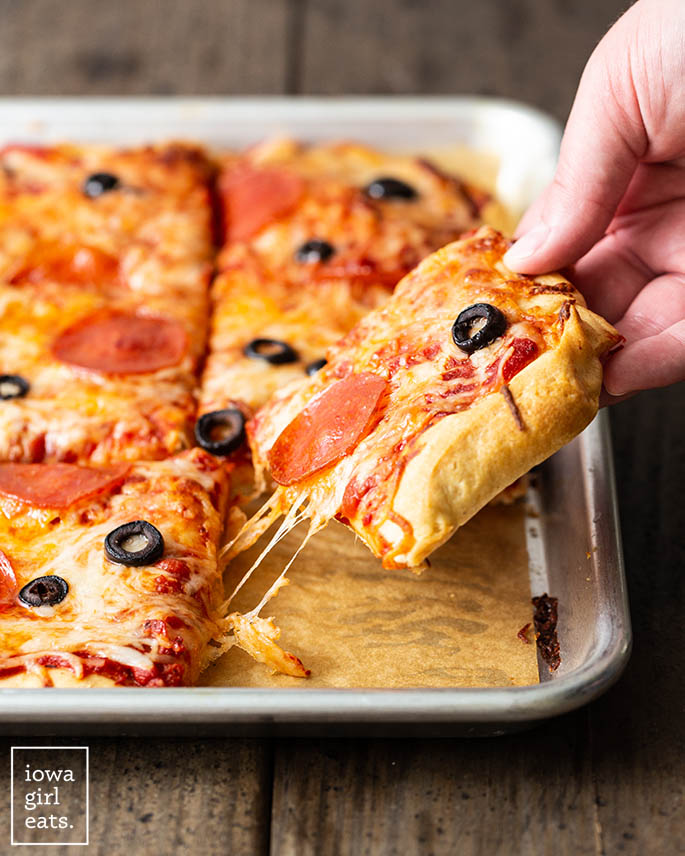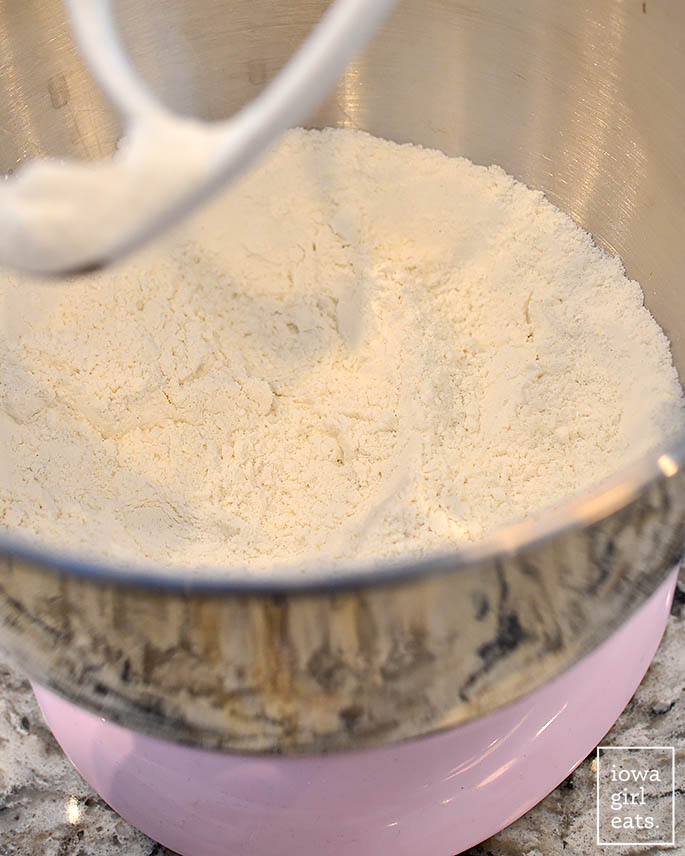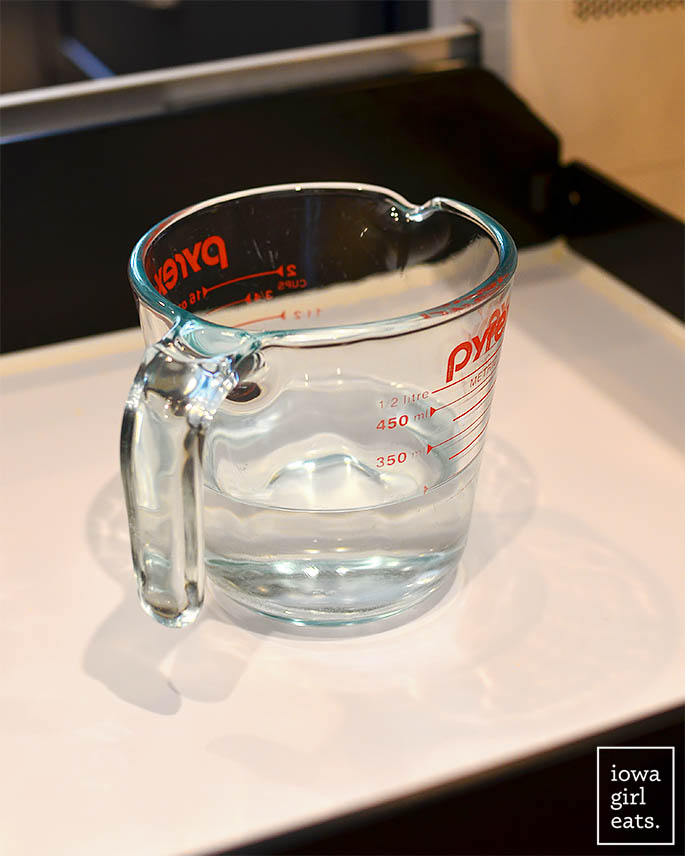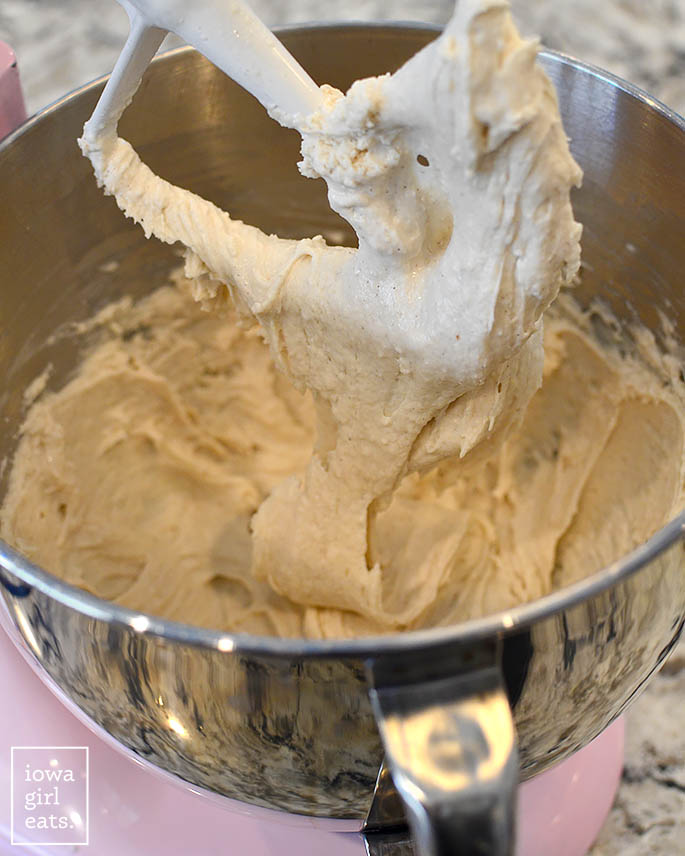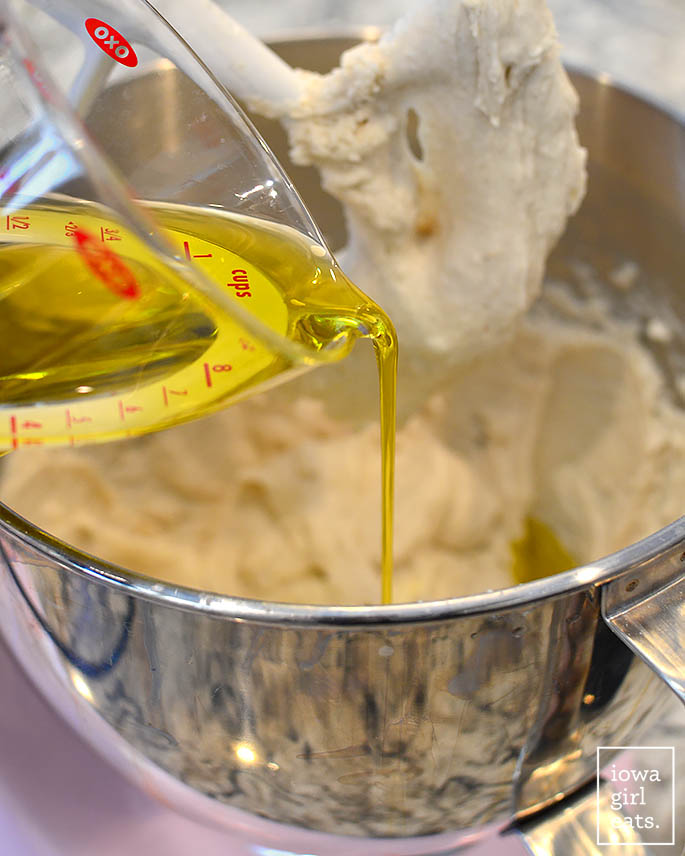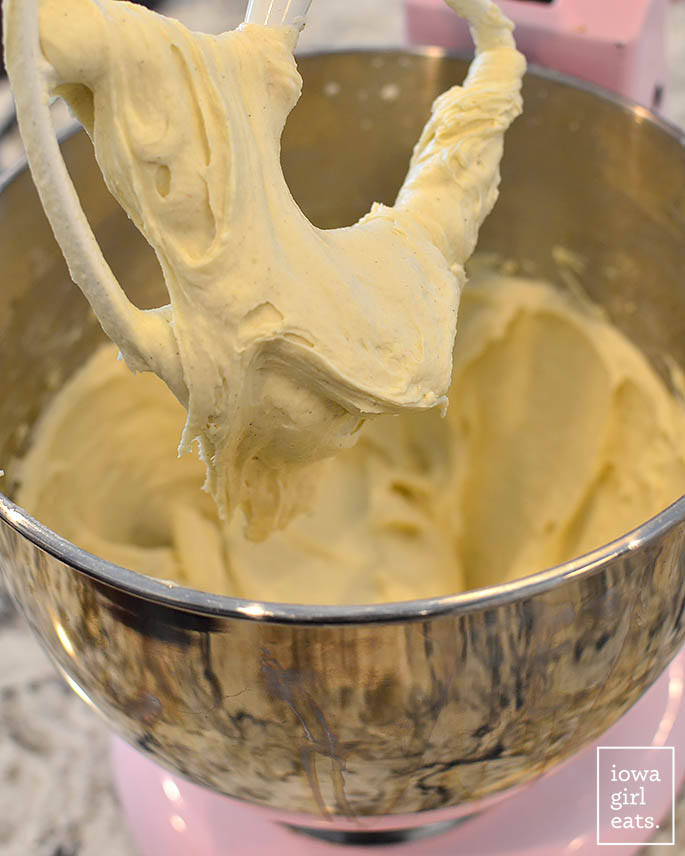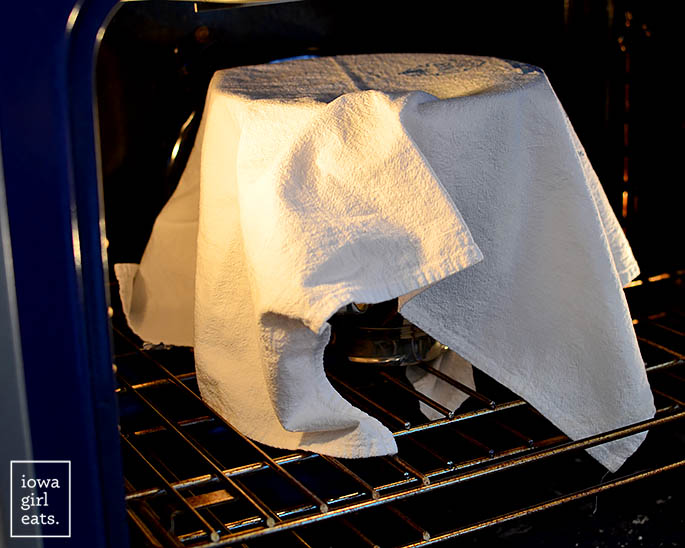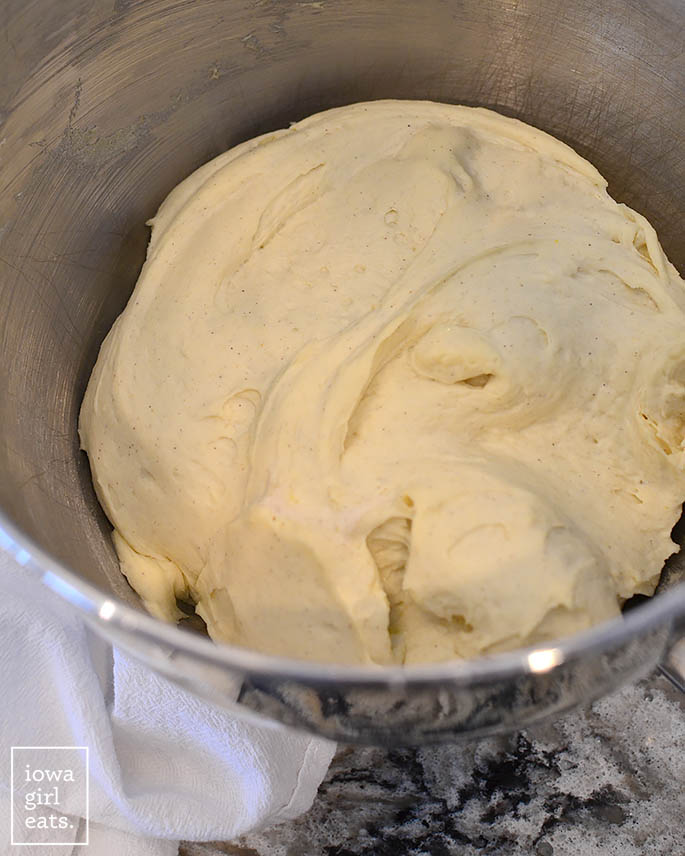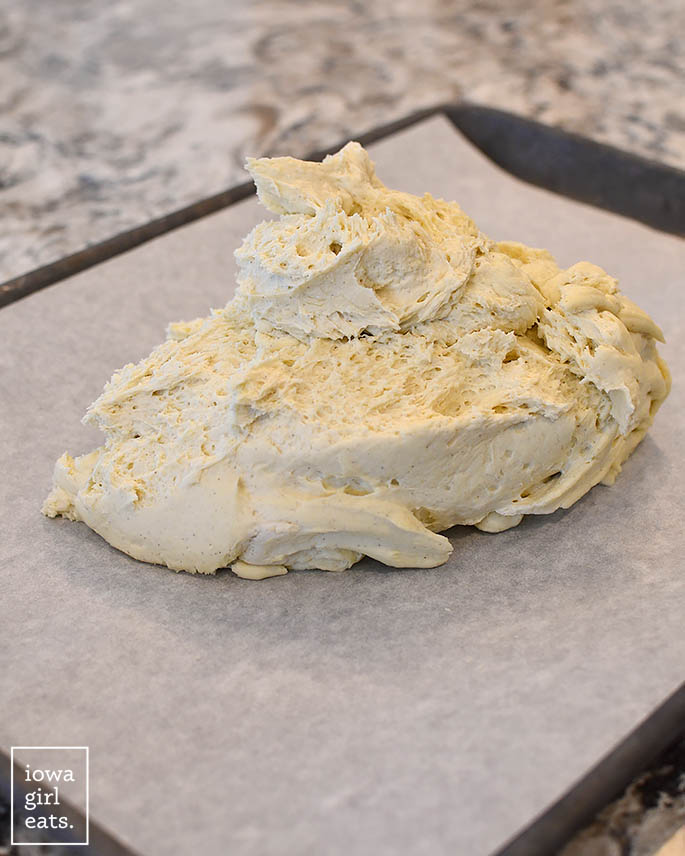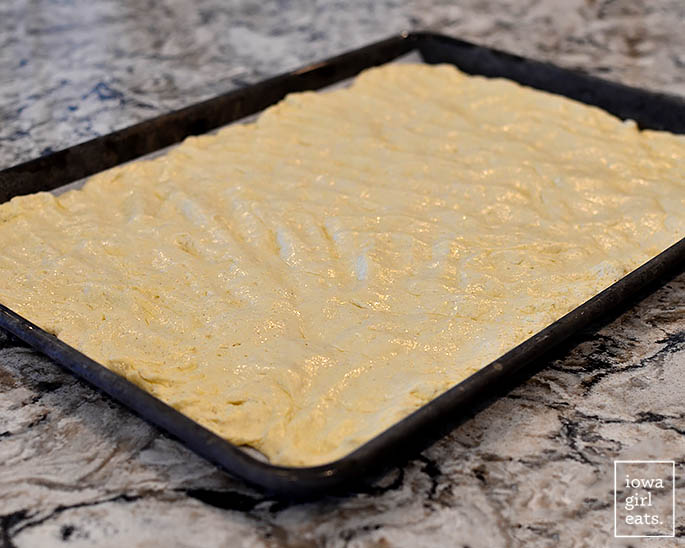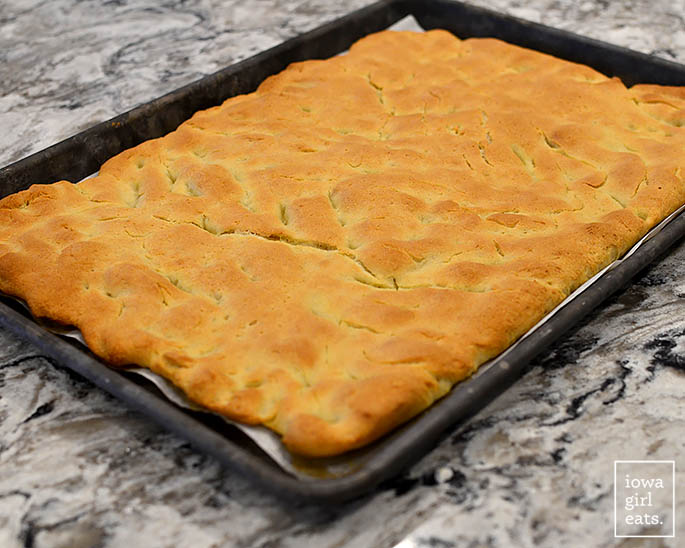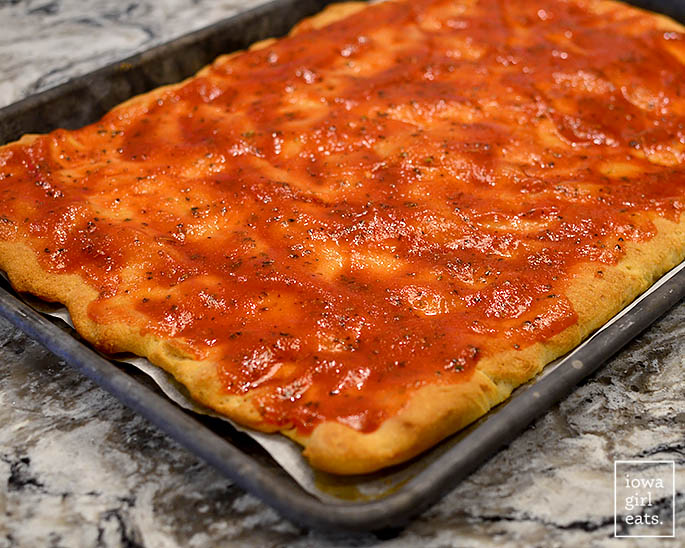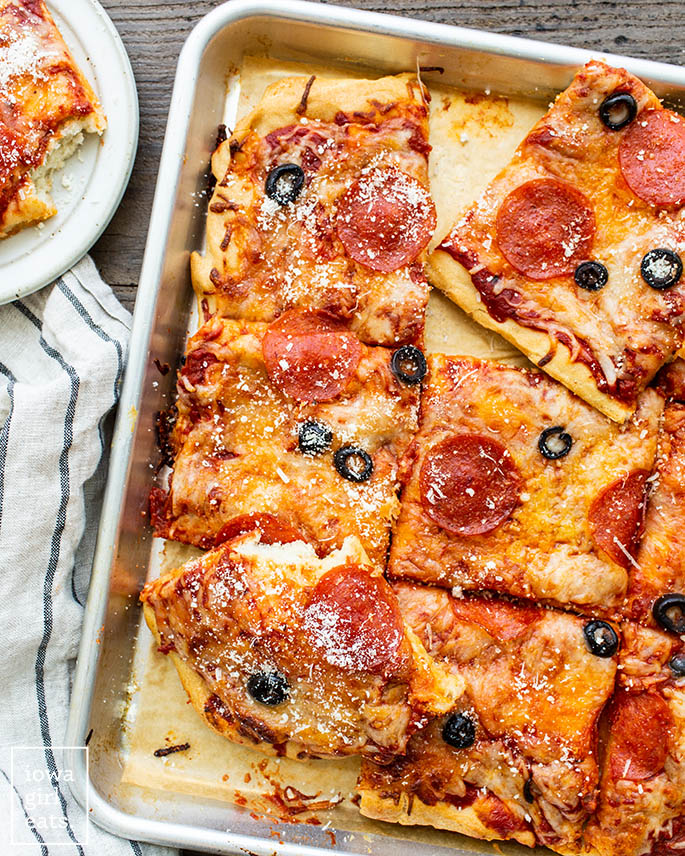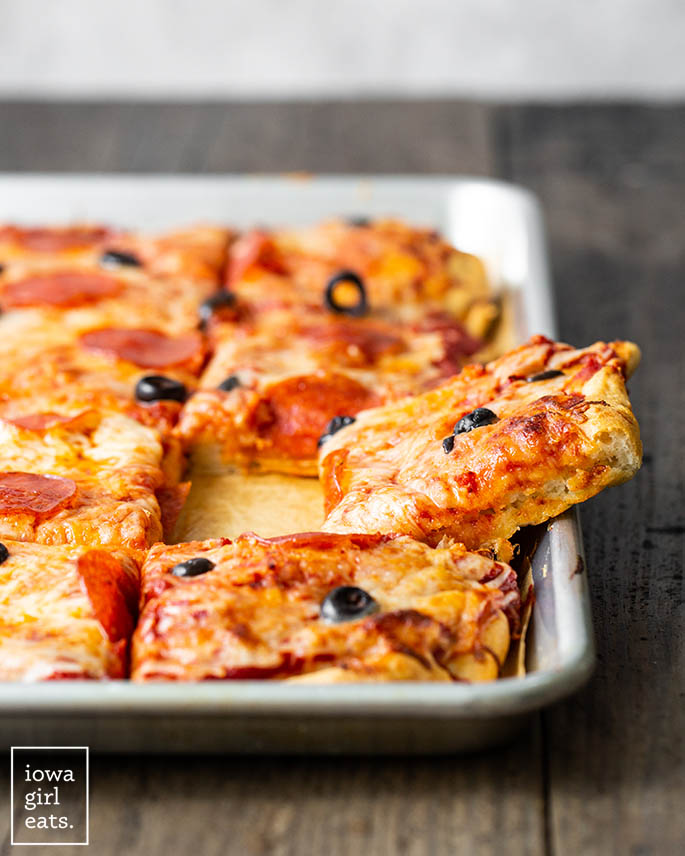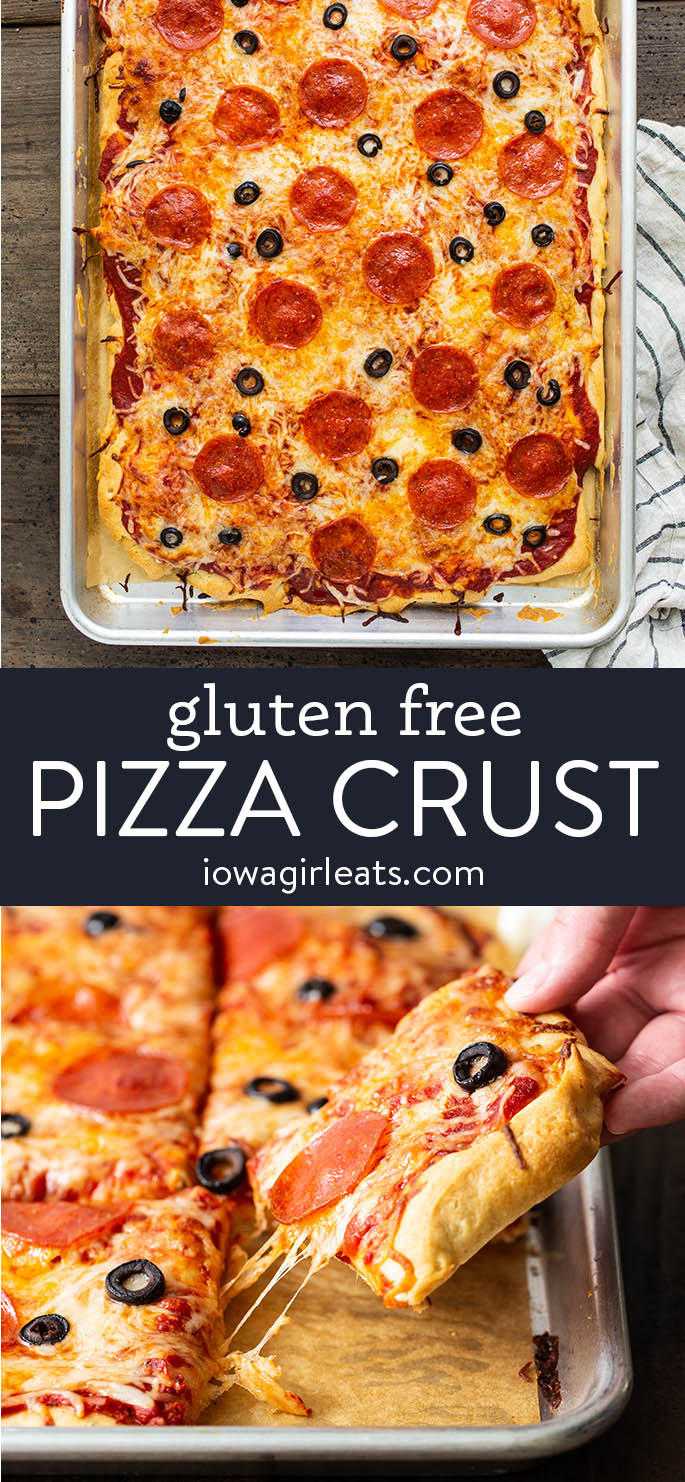Like many families, Friday night is pizza night at our house. But maybe unlike other families, our pizza order is a bit…complicated. I need a gluten-free crust on account of my Celiac Disease, Gwen needs a vegan crust and vegan cheese because she’s allergic to eggs and dairy, while the boys are happiest with regular crust and cheese. That said, what’s supposed to be a fun and easy dinner to look forward at the end of a busy week, can sometimes feel like more trouble than it’s worth. (Ok, that’s a lie – I’d go to the ends of the earth for pizza!) Needless to say, the recipe for Gluten Free Pizza Crust, which is not only gluten-free, but egg-free, and dairy-free (aka vegan) has COMPLETELY changed pizza night for our family. It’s a cinch to make, and freezer-friendly too!
Watch How to Make It
Gluten Free Pizza Crust — No Mix Needed
This gluten free pizza recipe is light, fluffy, and reminiscent of regular hand tossed pizza crust both in taste and texture. How many times have you bitten into a gluten free pizza crust that’s either soggy and floppy, or on the other end of the spectrum, hard and chalky? For me it’s too many times to count. Problem solved with this homemade, no-knead, airy, springy crust that feeds my entire family at once. I truly get giddy each time I make it, which is now weekly. ONE pizza that all five of us can eat? Together? At the same time?! Incredible! We like to press the dough into a half sheet pan, vs shape into a round pizza pan, then slice into squares and devour.
What is Gluten Free Pizza Crust Made Of?
I love that this gluten-free pizza crust recipe is made from gluten free pantry staples so I always have all the ingredients on hand. Here’s what you’ll need.
For the Gluten Free Pizza Crust:
Gluten free baking flour blend: I tested this recipe with five different gluten free flour blends. I’ll review the results below. Instant yeast: If you can open a packet of yeast, then you can make this gluten free pizza dough. Don’t be intimidated! We use quick rise instant yeast, and I like Red Star brand. Baking powder: Helps give the gluten free pizza a light and airy crust. Sugar: Feeds the yeast. You could use honey instead, if you’d like. Salt: To help balance the flavor of the dough. Water: To moisten the dough. Extra virgin olive oil: Makes the dough soft and chewy, plus gives it a gorgeous, golden brown glow!
For the Pizza:
Gluten free pizza sauce: Feel free to use marinara or spaghetti sauce if you have that on hand instead. Pizza blend cheese: Look for “pizza blend” cheese next to shredded mozzarella at the store. Imo it melts even better, and gives each pizza slice a craveable cheesy stretch. Toppings: Go nuts! We love pepperoni, cooked Italian sausage, and sliced black olives, but you can use whatever you like best. Peppers, Canadian bacon, artichokes, tomato, etc.
The Best Gluten Free Flour for Gluten Free Pizza Crust
If you’ve never made a homemade gluten free pizza crust base, the texture of the unbaked dough might surprise you. Compared to regular pizza recipes, which start with a stretchy dough that can be tossed, pulled, and rolled, you’ll need to press the gluten free dough into the baking pan with lightly oiled or watered fingertips. I’ve tested this gluten free pizza dough recipe with (what feels like) countless blends and brands of gluten free flour, and here’s what I’ll tell you: the flour matters. BUT you’ll notice a difference in the consistency of the uncooked batter/dough more than in the final baked pizza crust. Here’s what I mean:
When using Bob’s Red Mill Gluten Free 1-to-1 Baking Flour or King Arthur Gluten Free Measure for Measure Flour, the dough consistency is more like cake batter which you’ll need to spread to the edges of the pan using the back of a spoon, or an offset spatula. The batter does bake up into pizza crust fine, it’s just a little more dense than these photos show. When using Schar Mix It! Universal all purpose flour alternative, the dough is airy and springy so you can press it into the baking sheet with oiled or wet fingers. This is my preferred flour blend to use for this recipe. It’s new(er) to the market, so keep your eyes peeled! Of all the different flour blends I tested there was only one that was a hard no both in batter consistency AND final baked crust, which was Pamela’s 1:1 All Purpose Flour.
Moral of the story, if you can’t find Schar Mix It! Universal flour, and your unbaked gluten free pizza dough is more of a batter consistency, bake it up anyway — it should work fine!
Turn Into Individual Gluten Free Pizzas
Like I said, we like to bake the gluten free pizza crust in a half baking sheet pan, but sometimes I’ll split the dough into five even portions then form them into mini/individual-sized pizzas using a couple of half sheet pans. Kids especially love getting their own little pizza, plus they get to sauce and top it however they like.
Tips for the Best Gluten Free Pizza Crust Ever
Ok enough chatter, let’s get you some gluten free pizza!!
How to Make Gluten Free Pizza Crust
Step 1: Mix the wet ingredients. Start by adding gluten-free flour blend to the bowl of an electric stand mixer, or large mixing bowl if using a handheld mixture. Add salt, sugar, instant yeast, and baking powder then mix on low to combine. If you’re using a handheld mixer, use a whisk to combine the ingredients so they don’t fly out everywhere.
Step 2: Heat the water. Next heat water to 110 degrees in the microwave to activate the yeast. Too cool of water and the yeast won’t activate. Too hot and it could kill the yeast. A temperature between 110 and 115 degrees is ideal. I love using my Thermapen instant-read thermometer — just be sure to stir the water before taking its temperature to ensure you’re not sticking it into a cold or hot pocket of water.
Step 3: Mix the water into the dry ingredients. Pour the water into the dry ingredients then mix on medium speed until everything is smooth and combined. Let the batter rest for 1 minute so the gluten free flour can absorb the water.
Step 4: Add extra virgin olive oil. Add extra virgin olive oil to the mixing bowl then mix on low until the oil starts to incorporate. If you start with the speed too high, the oil will slosh out. No good! Once the oil begins to combine, turn the speed up to medium then beat for 1 minute.
Like I said, at this point your batter will be thick like cookie dough, or even a touch soupy like cake batter — but that’s ok! Use a spatula to give all the ingredients a good stir to make sure everything is well combined.
Step 5: Let the dough rise. Place a tea towel over the bowl of pizza dough then place it in a warm spot to rise for 30-40 minutes. I like to use my oven’s “bread proofing” setting, though you can use a warm spot in your home, or even place the bowl on top of a heating pad set to low.
Once the dough is nice and puffy (swoon!) it’s time to make some pizza. Crank the heat on the oven up to 425 degrees to get it ready to bake the crust.
Step 6: Press the dough out. Meanwhile, line a baking sheet with parchment paper then scoop the risen dough on top.
Spray the dough AND your hands very well with nonstick spray — alternatively you can lightly wet your fingertips with water — then press the dough into an even layer. It should fit perfectly inside the half sheet pan.
Step 7: Bake the crust. Pop the gluten free pizza crust into the hot oven then bake for 13-15 minutes, or until the crust is deep golden brown. Again, it’s better to slightly over-brown the crust at this point, vs underbake it to ensure the crust comes out light and airy, vs dense and gummy.
Step 8: Top the pizza with sauce and toppings. Spread pizza sauce, or spaghetti or marinara sauce, over the crust then top with your favorite toppings and bake for another 10-12 minutes or until the cheese has melted and the toppings are hot.
HELLO! Let the pizza cool ever so slightly, then zip through it with a pizza cutter and go to town! But first let’s settle a debate: ranch dressing with pizza? Or no ranch? You know this Midwesterner has her dipping cup of ranch nearby at all times when a hot slice of pizza is on her plate!
How to Store Leftover Pizza
This pizza reheats super well so stash any leftovers in an airtight container in the fridge then reheat on a plate in the microwave, or place the slices on a foil-lined baking sheet and bake in a 375 degree oven until heated through.
How to Freeze the Gluten Free Pizza Dough
I am so excited to tell you that this Gluten Free Pizza Crust freezes beautifully to make pizza night that much easier! Here’s what to do:
How to freeze gluten free pizza dough: Prepare the pizza crust through step 3 then scoop the risen dough into a Ziplock freezer bag, or other freezer-safe container, and freeze. Thaw for 24 hours in the fridge before pressing into the half sheet pan and baking per recipe instructions.
What do you think? Will you give this game-changing gluten free pizza crust a try? From our family to yours, ENJOY!
More Gluten Free Pizza-Inspired Recipes
Pizza Fries Gluten Free Pizza Breadsticks Pizza Pasta Bake Pizza Chicken Pizza Salad Mini Pizza Quinoa Bites
Photo by Ashley McLaughlin Like this recipe? Share it with friends!
